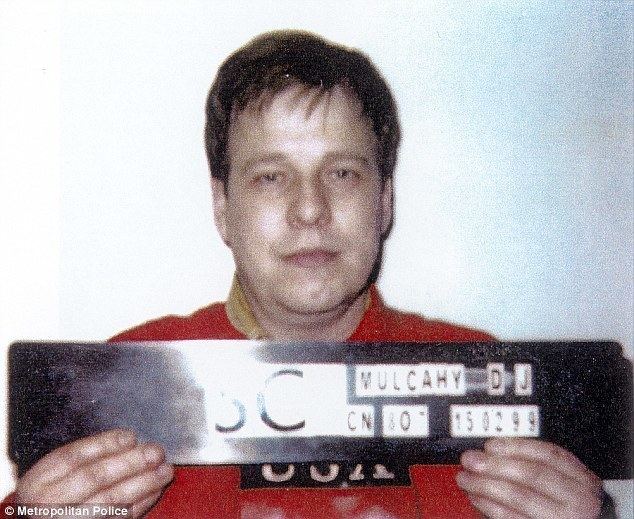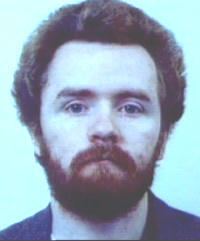Children 4 (Mulcahy) Victims 3 | Name John and | |
 | ||
Full Name John Francis DuffyDavid Mulcahy Born 1959 (age 55–56) England Other names The Railway KillersThe Railway Rapists Span of killings 29 December 1985–18 May 1986 Country England, United Kingdom | ||
John Duffy and David Mulcahy (both born 1959) are two British rapists and serial killers who together attacked numerous women and children at railway stations in the south of England during the 1980s. They are known as the Railway Rapists and the Railway Killers.
Contents

The attacks

In 1982, a woman (KJ) was raped by two men near Hampstead Heath railway station; and eighteen more were attacked over the next year. Even more occurred during 1984, and then three were raped on the same night in 1985 in Hendon. West London Police set up an urgent investigation to try to find the perpetrators, called "Operation Hart".
On 29 December 1985, Alison Day, 19 was on her way to meet her boyfriend at work in Hackney Wick. She was followed off a train at Hackney Wick station by Duffy and Mulcahy who grabbed her and she was repeatedly raped. She was then strangled with a ligature and tourniquet. Her body was sunk into the River Lea using discarded cobbles (granite sets). Metropolitan Police in East London set up a further separate investigation - Operation Lea.
Police further stepped up their search for the attacker who had been nicknamed by the press the "Railway Rapist". The death of Alison Day changed this name to the Railway Killer, a tag reinforced by the rape and murder of 15-year-old Maartje Tamboezer in West Horsley in Surrey on 17 April 1986. As well as rape and strangulation, Maartje's body was set on fire. Surrey Police set up Operation Bluebell. Meanwhile the Alison Day murder enquiry was taken over by Detective Superintendent Charles Farquhar (a highly experienced East London Murder investigator) and he linked that murder with the previous Railway rapes. He then drew a link with the murder of Maartje Tamboezer when he spotted that a belt and twig in a scene photo were the parts of a tourniquet ligature. A month later on 18 May 1986, Anne Lock, 29, a secretary at London Weekend Television was abducted and murdered after she alighted from a train at Brookmans Park railway station, Hertfordshire. This heralded the first multi Police Force murder enquiry (Operation Trinity) since the badly executed Yorkshire Ripper enquiry. It was the first such investigation to utilise basic computers and an early version of HOLMES (Home Office Large Major Enquiry System).
The name of Duffy, a martial arts exponent and former railway carpenter, was identified by Det. Supt. John Hurst as a suspect among thousands of other names. He was a known sex offender, having been previously convicted of the rape of his wife, whom he is known to have informed of his belief the act of rape was a "natural male instinct".[1] A type of rare string called 'somyarn' was found in his parents' house. This linked him to the second murder victim. His experience of traditional bow saws linked him to the unusual method of strangulation using a self fashioned tourniquet and his knowledge of the South Eastern Rail system was part of his former job. David Mulcahy was also questioned due to his close friendship with Duffy, but victims were still traumatised and unable to pick him out of an identity parade (at that time identity parades required the victim to physically touch the offender and get close to him). Mulcahy was released for lack of evidence.
New methods
To help their inquiries, the police brought in a psychologist from the University of Surrey, Dr David Canter, who was working in the field of geographical psychology at the time. There had been no previous use in Britain of "psychological offender profiling" as it was known, but something fresh was required as two women and a child had been murdered and numerous others raped, with little progress being made. Canter examined the details of each crime and built up a profile of the attacker's personality, habits and traits. While this continued, another attack took place, when a 14-year-old girl was raped in a park.
This enquiry led Dr Canter to set up Investigative Psychology.
Breakthrough
As well as working together with Mulcahy, Duffy had started to rape alone and he was arrested while following a woman in a secluded park. He was also questioned about the spate of rapes and murders, and the next day he was charged on all counts. Police knew that he had not committed the offences alone, but Duffy was not forthcoming about his accomplice.
Trial and conviction
Duffy went on trial in February 1988 and was convicted of two murders and four rapes, although he was acquitted of raping and killing Anne Lock (Lock's body had not been found until weeks after her murder, meaning DNA evidence could not be found on her body). He was given a minimum tariff of 30 years by the judge, later extended to a whole life tariff by the Home Secretary. A European Court of Human Rights ruling later removed the right of politicians to reset sentence tariffs, and so Duffy's stay in prison was reverted to the original 30 years.
Much was made of the psychological profile constructed by Canter after the trial, as Duffy fitted 13 of the 17 observations made about the attacker's lifestyle and habits. Such profiling became commonplace in policing thereafter.
Accomplice is found
Following his conviction, Duffy revealed to a forensic psychologist what the police knew already - that he had not attacked the women alone. However, he chose to reveal no more until 1997, when he implicated Mulcahy, a lifelong friend with whom Duffy had been inseparable since their days together at school in Haverstock, North London. Whilst in school they were once excluded as they were found laughing and covered in blood after bludgeoning a hedgehog. Duffy also admitted his involvement in the attack on Anne Lock, although he could not be re-tried for this under the double jeopardy rule (now abolished).
However, Mulcahy - a married father of four - could still be implicated, and following Duffy's claims he was tracked for several months by police prior to his arrest; DNA-tests (which were not yet in use during the original investigation) also conclusively proved his involvement. In 2000, Duffy appeared at the Old Bailey as a witness against Mulcahy and gave detailed evidence over fourteen days. It was the first time a highest-category prisoner had given evidence against an accomplice.
Prosecution evidence at the trial presented Mulcahy as the chief perpetrator and the first to decide that sexual stimulation wasn't enough of a thrill any more, so turning to murder.
Mulcahy was convicted of three murders and seven rapes and handed three life sentences, with a 30-year recommendation. He was not later given a whole life tariff, as the ruling barring politically set tariffs had been made by the time his case was due for review.
Duffy was convicted of 17 more rapes and received a further 12 years. Neither man is expected ever to be released from prison. Police suspect them of countless other sex attacks, some dating back to the mid-1970s, while Mulcahy is also suspected of attacks which took place after Duffy was jailed.
There has been occasional publicity for the pairing since Mulcahy's imprisonment, including newspaper claims that Duffy was paid £20,000 in return for information about his accomplice, and that Mulcahy has become a feared loan shark from his prison cell.
In 2001, a television documentary Witness of Truth: The Railway Murders was broadcast. In 2016, a book was written about the case, entitled A Dangerous Place: The Story of the Railway Murders.
